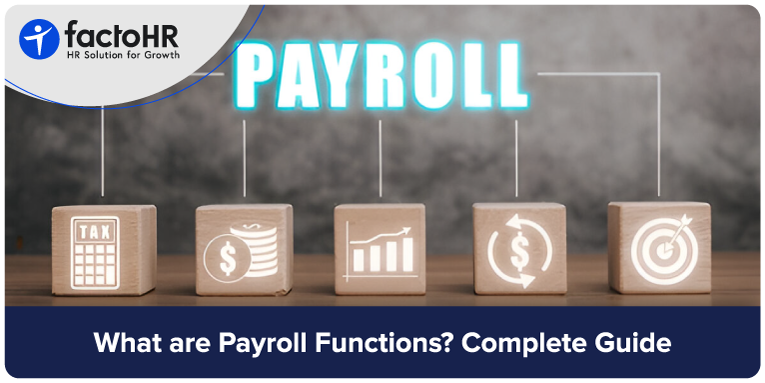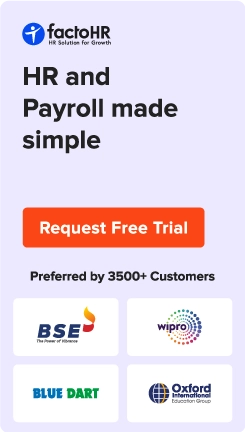Payroll Functions: Complete Guide & Best Practices for 2025

Table of Contents
Can outdated payroll practices disrupt an organization’s payroll processing and lead to its mismanagement? Traditional payroll practices can sometimes cause significant damage to the organization, both financially and legally. Manual methods of payroll processing are outdated and are also unable to keep pace with the constant changes in tax laws and regulations. This rigidity, rooted in old ways, can result in errors that can cost companies their reputation.
Other payroll functions that are often absent in outdated systems include proper compliance with labor laws and strong security measures. Organizations need to focus on updating their payroll systems from traditional ones to more adaptable and flexible ones. This is why it is important to gain knowledge of core payroll-related features. This article will discuss some of the key payroll functions to help organizations manage payroll-related tasks effectively.

What are Payroll Functions?
Payroll functions refer to the process of paying salaries to employees after deducting taxes and other required amounts. It includes salary calculations based on employees’ total working hours and statutory deductions. Payroll functions also help maintain tax compliance with labor laws and accurate records for the audit process. It is an essential process for businesses to ensure that employees’ salaries are calculated correctly and that they meet all legal requirements on time.
Organizations should know that payroll functions are designed to simplify complex tax calculations and minimize the risk of manual errors. The software allows employees to stay updated with payroll policies and provides them with an idea of the company’s ongoing changes. Being informed about the changes helps increase employee engagement and enhance their overall experience within the organization.
Key Payroll Functions Explained
A good payroll software includes multiple functions, which can help organizations simplify their payroll processes. Some of these features are explained below for more understanding.
Employee Data Management
Employee data management is essential for accurately calculating payroll and tax deductions to meet compliance requirements. One key payroll function that the software includes is a centralized data management system. All the employee data is stored in one place, which helps HR professionals retrieve information easily. The software can easily add new employees, allowing organizations to scale with the increasing number of employees.
The software provides regular maintenance, including the latest features to help simplify the process more effectively. It also helps reduce the need for manual data entry and the risk of errors. Another key payroll function is integration with other systems, like attendance systems and the Human Resource Information System (HRIS). This feature reduces data redundancy and prevents confusion related to data, thereby enhancing accuracy.
Payroll software can also generate various reports, helping organizations identify trends related to payroll and other aspects. HR professionals and organizations can make informed decisions when they have access to real-time employee data.
Time & Attendance Tracking
It is important to track employee attendance for calculating accurate salaries and classifying them into applicable tax brackets. Accurate time and attendance tracking is beneficial for organizations, as it ensures that employees’ salaries are proportionate to the hours worked. Organizations record employees’ attendance through a biometric attendance system, which calculates time-in and time-out punches, as well as overtime. This attendance system simplifies and integrates with payroll software to process payroll.
Another payroll function also provides insights into employees’ schedules, including their attendance patterns and absenteeism, which can be used for effective workforce planning. These workforce management decisions are also based on compliance with international and national labor laws. The insights from data can help organizations generate reports to identify employee trends and take action in areas for improvement.
Salary Calculation
Salary calculation is one of the most basic payroll functions, which includes calculating the gross wages of an employee. Then, various amounts, such as the provident fund and professional tax, are deducted from the gross pay. The payroll software can automatically calculate the net salary after deducting the gross amount. The software can also calculate the latest taxes, like income tax and other deductions, helping companies stay compliant with tax laws and avoid financial penalties.
Another payroll function includes generating salary payslips for employees, which employees can access through an employee self-service (ESS) portal. Employees can manage their payroll-related tasks without needing HR professionals, and help increase engagement.
Deductions & Withholdings
Payroll functions include calculating and withholding national and local taxes, a key feature that ensures proper compliance with laws. It can manage payroll deductions related to employee benefits, like health insurance and retirement contributions. Some of the payroll software is designed in such a way that it manages wage garnishments as well. It means employers can withhold a portion of an employee’s paycheck to pay off a debt.
Deductions and withholdings are automated to help organizations reduce the risk of errors and maintain compliance with labor laws. The automation helps save time and effort for any organization, which allows HR professionals to focus on other strategic tasks.

Payroll Processing
Payroll processing is an end-to-end procedure in payroll functions that also includes salary calculation. In addition to salary calculation, it involves some additional steps and compliance requirements. The whole process is divided into three main steps. These are mentioned below:
- Pre-payroll activities
This step involves establishing payroll policies and collecting all employee data. All the employees’ pay structures are evaluated, and compliance requirements with laws are taken into consideration.
- Actual Payroll Processing
The salaries are calculated based on attendance records and overtime factors. Provident fund (PF) and tax deducted at source (TDS) are deducted at this stage to arrive at the net salary. This calculated salary is then distributed to employees through various payment methods, such as cheque or bank transfer.
- Post-payroll activities
A comprehensive payroll guide encompasses salary calculations and the filing of payroll taxes, ensuring accurate payroll records for statutory compliance.
The process makes sure that employees are paid accurately and on time, and maintains proper compliance by reporting.
Payslip Generation & Distribution
Payroll software calculates employees’ net pay after deducting necessary taxes, which allows employees to receive accurate payment. Once the salaries are distributed, the software automatically generates payslips. Payslip generated includes data related to net salary and other deductions, helping HR professionals save time on employees’ queries regarding their pay.
Payslips are generated and distributed via email and an employee self-service portal. This distribution provides employee with a clear record of their earnings and deductions, which leads to transparency.
Payroll Disbursement
Payroll disbursement is a key payroll feature that ensures the timely and accurate payment of salaries to employees. The process includes calculating employees’ wages and ensuring compliance with various deductions. This is an all-in-one process that allows businesses to avoid non-compliance with the employment laws and regulations.
When organizations automate the payroll disbursement process, they can reduce the chance of manual errors and increase employee satisfaction. As payroll processing is accurate, employees trust their companies, and providing access to an employee self-service (ESS) portal can increase overall engagement.
Payroll Accounting & Reporting
Another payroll function, in addition to salary calculation, includes accounting and reporting. Payroll software can also generate various reports, like tax forms and compliance reports, for accurate tax filing. Organizations can make informed decisions with the help of these reports, which provide insights into trends and patterns related to payroll. Tracking payroll data and its analysis enables organizations to understand key aspects, including employee engagement and compliance management.
Organizations can also generate reports related to labor costs and productivity to help understand payroll expenses. Integration with HR software and other systems allows the management of data, allowing every department to make informed decisions based on various reports. Businesses can track payroll-related changes, as some software solutions are configured to provide audit trails.
Statutory Compliance & Tax Filing
With the advancement of technology, new updates and features can be added to payroll software. Statutory compliance and changes in tax rules are among the updates included. These updates are provided to organizations to ensure statutory compliance with the Employee Provident Fund (EPF) and the Employee State Insurance (ESI). The payroll software provides reports for tax filing and review purposes, including those for audits.
There are other statutory regulations, for example, gratuity, which are also deducted from employees’ salaries after they have completed their long-term service. All of these rules and regulations help businesses to stay compliant and avoid financial penalties.
Year-End Processing
Payroll software can generate tax-related forms, such as Form 16 and the Income Tax Return (ITR), which are required for year-end reporting purposes. HR practices and payroll data should comply with local and national tax laws to ensure legal compliance. Year-end processing enables organizations to verify and update data as needed. It helps organizations to ensure accuracy in reporting and prepare for the new financial year. The last step after year-end processing is reconciliation of reports, which can be used for future reference.

Conclusion
The payroll functions mentioned above demonstrate that the software can help businesses achieve growth and success. As an important component in business operations, the software ensures that employees’ payroll is processed accurately and on time, with proper compliance with labor laws. When payroll processes are simplified, HR professionals can focus on other important employee-related functions. Auditing the current payroll processes can help organizations identify errors and take corrective actions.
A well-managed payroll processing can contribute to regulatory compliance and the overall growth of an organization. factoHR’s cloud-based payroll software can help organizations simplify payroll processing and maintain compliance with employment laws. Schedule a demo now to know more!
What are the Main Functions of Payroll?
The main functions of payroll are:
- Salary Calculation and Payment
- Handling Deductions and Benefits
- Payslip Generation
- Record Keeping and Documentation
- Payroll Tax Administration and Compliance
- Responding to Queries and Reporting
- Ensuring Data Security and Confidentiality
What are the Future Trends of Payroll?
The future trends of payroll are centered on technology and its ongoing development. These advancements are utilized in areas such as simplifying payroll processing and enhancing employee well-being. AI and machine learning are used to automate tasks such as tax calculations and report generation, enabling informed decision-making. Also, cloud-based payroll software provides flexibility and scalability to organizations.
What are the Stages of Processing Payroll?
There are 3 main stages in payroll processing, which are mentioned below.
- Pre-Payroll
- Gather employee information
- Establish a payroll policy
- Monitor attendance and leave
- Actual Payroll Calculation
- Calculate gross pay
- Calculate deductions
- Calculate net pay
- Post-Payroll
- Disburse salaries and issue payslips
- Submit statutory reports and deposit deductions
- Record-keeping and accounting
- Update payroll records
How do I Choose the Best Payroll Software?
Organizations should first assess their needs and understand their requirements. There are multiple factors that should be considered in payroll processing, like the number of employees and integration with other systems. Compare payroll software features with different options available in the market by their price and security measures.
Grow your business with factoHR today
Focus on the significant decision-making tasks, transfer all your common repetitive HR tasks to factoHR and see the things falling into their place.

© 2026 Copyright factoHR


